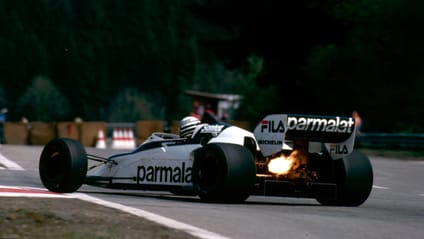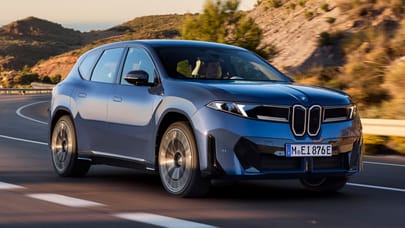
Top Gear's coolest racing cars: the Brabham BT52
Currently strapped onto a giant spike at Goodwood, meet one of BMW's stars


This week’s coolest racing car is currently strapped to a giant metal spike, about 20 metres above the ground, and centre-stage outside Goodwood House in the latest of artist Gerry Judah’s spectacular sculptures. Along with a 1940 328 MM roadster and the glorious LMR V12 that won Le Mans in 1999, the Brabham BT52 is one of three BMWs chosen to celebrate the company’s centenary at the 2016 Goodwood Festival of Speed. It’s a highly symbolic indication of where it sits in a 100-year pantheon that’s not exactly short of high points.
Advertisement - Page continues below
The BT52 is also a major entry in the bulging CV of a certain Gordon Murray. When the FIA banned ‘ground effect’ aerodynamics in 1982 in favour of flat bottoms, Murray’s response was a mix of his signature engineering genius and sly ability to figure out a way of making the regulations work for him. Formula One loves genius and opportunism. But Murray was also brave.

The resultant car still looks like no F1 car before or since, its aggressively arrow-shaped chassis and abbreviated side-pods designed to reclaim the downforce lost in the regressive rule change. The monocoque was a mix of aluminium and carbonfibre, and the return of refuelling meant that Murray was able to gamble on a smaller fuel tank in an effort to minimise weight. There were big wings, front and rear, chasing more downforce, and relatively conventional front and rear suspension.
Advertisement - Page continues below
But the BMW turbo engine was something else. Famously, this 1.5-litre four-pot was based on a long-running production block, a cast-iron one, boosted by a KKK turbo. Various myths have accrued to this particular BMW unit; it’s said that some of the blocks had already racked up huge mileages before being effectively repurposed for race duty, and one BMW figure – who should probably remain nameless – told me that the mechanics would actually urinate on the blocks, then leave them outside for days on end, an unusual but apparently effective way of proving fitness for purpose and durability. The power output ran at around 640bhp in race trim, up to 800bhp for qualifying.

The team itself was still being run by some bloke called Bernie Ecclestone, who maintained the previous season’s driver line-up in the shape of 1981 world champion, Nelson Piquet (pictured), and Italian charger Riccardo Patrese. The BMW-powered cars wore the distinctive livery of long-defunct supermarket Parmalat, and managed to upstage their contemporary Ferraris and Renaults in terms of visual élan. Piquet and Renault’s Alain Prost battled hard all season, Piquet prevailing on the back of continued development of the BMW engine. Early problems with traction, reliability and driveability were all gradually ironed out.

So it was that Brabham scored the first F1 world championship with a turbocharged car, at the expense of the French team who had pioneered the technology six years earlier. The testy Brazilian won three races, and scored consistent podium finishes. Patrese, on the other hand, was plagued with bad luck, and managed a solitary win in the last round at Kyalami, in South Africa. TG.com nabbed him at the Festival of Speed for a download.

"This is the first time I’ve driven the BT52 since I won the South African GP in one. The driveability is better than I remember… I suspect there might be some modern electronics in the car and turbo. I remember seeing the car for the first time. With Gordon, well you just had to trust that he knew what he was doing. He was a genius, after all, and this car was a good surprise, shall we say… He was determined to reduce weight, to get as much over the back of the car for maximum traction. I was often something of an experiment, trying things out that might later appear on Piquet’s car. That sometimes meant I had the faster car, but it was also often not reliable, too.
"People talk about that great first turbo era, but remember we weren’t running massive horsepower in the race, just qualifying. At the time, a pole position was just as satisfying as a strong race, because the cars were simply so powerful. Nowadays, there are drivers in F1 who are 18. That wouldn’t have happened back then. The cars, and the circuits, were just too dangerous."
Advertisement - Page continues below
Brabham-BMW BT52
Year: 1983
Engine: 1499cc, 640-800bhp
Drivers: Nelson Piquet, Riccardo Patrese
Highlight: becoming the first turbo car to win the F1 championship in the first turbo era
Trending this week
- Car Review
BMW iX3







